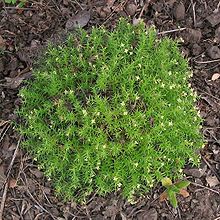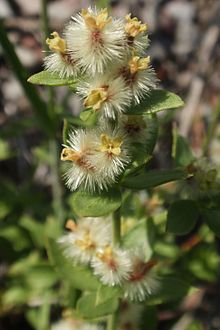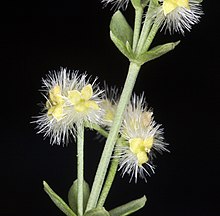Bed herbs
| Bed herbs | ||||||||||||
|---|---|---|---|---|---|---|---|---|---|---|---|---|

White bedstraw ( Galium album ) |
||||||||||||
| Systematics | ||||||||||||
|
||||||||||||
| Scientific name | ||||||||||||
| Galium | ||||||||||||
| L. |
The Galium ( Galium ) are a genus within the family of the redness plants (Rubiaceae). Most of the more than 600 species thrive in the temperate climate of the northern and southern hemispheres .
Description and ecology


Appearance and leaves
The Galium species are annual to perennial herbaceous plants , rarely subshrubs . The upright or climbing stems are, at least as long as they are young, square and often clearly prickly or burr-like. There are raphids.
In many species it looks as if there is a multi-leaved (four to twelve) leaf whorl . These are opposite leaves and their uniformly shaped, leaf-like stipules . These leaves are usually sessile, rarely stalked. Leaves and stipules can be fused together. The interpetiolar stipules are reduced in some species. The leaf margins are smooth or serrated. There may be glands on the underside of the leaf. There is usually one major nerve on the leaf surfaces, but sometimes there can be three or more.
Inflorescences and flowers
The flowers are singly or in groups in a single or branched, zymous inflorescence . The flower stalk sometimes elongates until the fruit is ripe, but it is usually relatively short or absent.
The flowers are mostly hermaphroditic, sometimes they are unisexual and then the species are andromonocial , seldom polygamo-dioecious or dioecious . The relatively small flowers are radial symmetry and usually four-fold, more rarely three or five-fold. The flower cups (Hypanthium) is the ovary grown. There are usually four, sometimes three or five sepals , but often the calyx is only rudimentary or absent. The mostly four, rarely three or five petals are more or less broadly fused to seldom bell-shaped; sometimes the corolla-tube is so short that it acts as if the petals were free. The color of the inside bare petals is white to yellow, yellowish green to green, more rarely pink to red to purple. There is only a circle of mostly four, rarely three or five fertile stamens . The well-developed to more or less reduced stamens are inserted near the base of the corolla tube. The anthers are dorsifix. Two carpels are fused together to form a subordinate, bicameral, egg-shaped, ellipsoidal or spherical ovary, the surface of which is smooth, papilose, warty, covered with hook-shaped or rarely straight trichomes , depending on the species . There is only one erect ovule per ovary chamber . The originally two styles are free or fused up to the top, but then with two distinct scar branches that protrude above the corolla. There is a discus . The pollination is usually by insects ( Entomophilie ).
Fruits and seeds
When ripe, the fruits are green, gray, rarely white, red, orange or black. The ellipsoidal to almost spherical split fruits disintegrate into two solitary partial fruits. The fissure fruits are usually dry to leathery, rarely spongy, rarely more or less fleshy and berry-like. The almost spherical, ellipsoidal or kidney-shaped partial fruits are smooth and glabrous to warty and / or covered with trichomes , which are often hook-shaped. The relatively small seeds are grooved on the ventral side. The seed coat (testa) is membranous. The curved embryo has two cotyledons leaf-like leaves ( cotyledons ).
Origin of name
The name bedstraw comes from its use as an acidulant in cheese making . The scientific name Galium (from Greek : Gala = milk ) is also derived from it.
Systematics and distribution











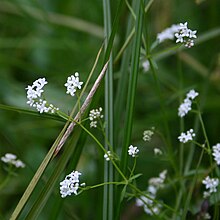

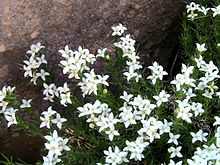





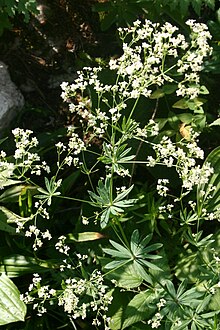



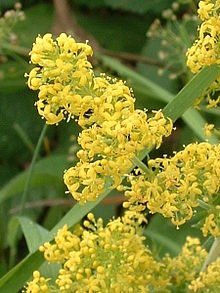
The genus Galium was established in 1753 by Carl von Linné in Species Plantarum , 1, page 105. Synonyms for Galium L. are: Aparinanthus Fourr. , Aparine Guett. , Aparinella Fourr. , Bataprine Nieuwl. , Chlorostemma Fourr. , Eyselia Neck. , Galion St.-Lag. , Gallion Pohl , Gallium Mill. , Relbunium (Endl.) Hook. f. , Trichogalium Fourr. , Aspera Moench .
The genus Galium belongs to the subtribe Rubiinae of the tribe Rubieae in the subfamily Rubioideae Verdc. within the family of the redness plants (Rubiaceae).
The genus Galium is found almost worldwide. The species thrive mainly in meridional to temperate zones, but also in alpine and arctic areas or in subtropical to tropical zones at higher altitudes. There are about 63 species in China, 23 of them only there. For example Galium saxatile , Galium schultesii , Galium verum are considered invasive plants in some areas, for example California .
The genus Galium is divided into sections (selection):
- Galium section of Aparinoides
- Galium Section Baccogalium
- Galium section Bataprine
- Galium section Depauperata
- Galium Section Galium
- Galium Section Hylaea (Griseb.) Honorable.
- Galium section Jubogalium
- Galium section Kolgyda
- Galium Section Leiogalium
- Galium Section Leptogalium
- Galium Section Lophogalium
- Galium Section Miscellaneous
- Galium section Orientigalium
- Galium section Platygalium
- Galium section Relbunium
- Galium Section Trachygalium
species
The genus Galium contains over 600 species:
- Galium abaujense Borbás
- Galium abruptorum pomel
- Galium absurdum Krendl
- Galium Achurense Grossh.
- Galium acrophyum Hochst. ex Chiov.
- Galium acuminatum ball
- Galium acutum Edgew.
- Galium adhaerens Boiss. & Balansa
- Galium advenum Krendl
- Galium aegeum (Stoj. & Kitam.) Ancev
- Galium aetnicum Biv.
- Honoring Galium afropusillum .
- Galium agrophilum Krendl
- Galium aladaghense Parolly
- Galium × albertii Rouy : This hybrid of Galium boreale × Galium verum occurs only in France .
- Galium albescens Hook. f.
-
White bedstraw ( Galium album Mill. ): There are five subspecies:
- Galium album Mill. Subsp. album : It occurs from Europe to western Siberia and from North Africa to Sudan .
- Galium album subsp. Honoring amani . & Finishing Tem. : It occurs from southern Turkey to Lebanon .
- Galium album subsp. prusense (K.Koch) Honorable. & Krendl : It occurs from northern Turkey to Transcaucasia , on the Balkan Peninsula and on the Crimea .
- Galium album subsp. pycnotrichum (Haw. ex Schult. & Schult. f.) Krendl : It occurs from Eastern Europe to Western Turkey.
- Galium album subsp. suberectum (Klokov) Michalk. : It thrives in the Eastern Carpathians .
- Galium amatymbicum Eckl. & Zeyh.
- Galium amblyophyllum Schrenk
- Galium amorginum Halácsy
- Galium andrewsii A. Gray
- Galium andringitrense Homolle ex Puff
- Galium anfractum Sommier & Levier
- Galium anguineum Honoring. & Finishing Tem.
- Galium angulosum A. Gray
- Galium angustifolium Nutt.
- Galium angustissimum (Hausskn. Ex Bornm.) Honorable.
- Uneven-leaved bedstraw or Alpine bedstraw ( Galium anisophyllon Vill. )
- Galium ankaratrense Homolle ex Puff
- Galium antarcticum Hook. f.
- Galium antitauricum Honoring.
- Galium antuneziae Dempster
- Burdock bedstraw , also sticky bedstraw ( Galium aparine L. )
- Galium aparinoides Forssk.
- Galium aragonesii herdsmen
- Galium araucanum Phil.
- Galium arenarium Loisel.
- Galium arequipicum Dempster
- Galium aretioides Boiss.
- Galium argense Dempster & Ehrend.
- Awn bedstraw ( Galium aristatum L. )
- Galium arkansanum A. Gray
- Galium armenum Schanzer
- Galium ascendens Willd. ex explos.
- Galium aschenbornii showers
- Galium asparagifolium Boiss. & Hero.
- Galium asperifolium Wall.
- Galium asperuloides Edgew.
- Galium asprellum Michx.
- Galium atherodes Spreng.
- Galium atlanticum pomel
- Galium aucheri Boiss.
- Galium auratum Klokov
- Galium australe DC.
- Austrian bedstraw ( Galium austriacum Jacq. )
- Galium avascense Krendl
- Galium azerbayjanicum Honoring. & Finishing Tem.
- Galium azuayicum Dempster
- Galium babadaghense Yıld.
- Galium baeticum (Rouy) Honoring. & Krendl
- Galium baghlanense Honoring. & Finishing Tem.
- Galium baillonii Brandza
- Galium baldense Spreng.
- Galium baldensiform hand .-- Mazz. : It thrives at altitudes of 2800 to 4300 meters in the Chinese provinces of Qinghai , Sichuan , Yunnan (only in Lijiang ) and in Tibet .
- Galium balearicum Briq.
- Galium × barcinonense Sennen (= Galium lucidum × Galium maritimum ): It occurs only in Spain .
- Galium basalticum Honoring. & Finishing Tem.
- Galium baytopianum Honoring. & Finishing Tem.
- Galium beckhausianum G.H.Loos
- Galium belizianum Ortega Oliv., Devesa & Rodr.Riaño
- Galium bellatulum Klokov
- Galium bermudense L.
- Galium bifolium S. Watson
- Galium bigeminum Griseb.
- Galium binifolium N.A. Wakef.
- Galium blinii H.Lév. : It thrives at altitudes of 800 to 3000 meters in the Chinese provinces of Guizhou , Hubei , Shaanxi , Sichuan, Yunnan and in Tibet.
- Galium boissierianum (Steud.) Honorable. & Krendl
- Galium bolanderi A. Gray
- Nordic bedstraw ( Galium boreale L. )
- Galium boreoaethiopicum Puff
- Galium bornmuelleri Hausskn. ex Bornm.
- Galium bourgaeanum Coss. ex batt.
- Galium boyacanum Dempster
- Galium brachyphyllum Schult.
- Galium bracteatum Boiss.
- Galium bredasdorpense puff
- Honoring Galium brenanii . & Verdc.
- Galium brevifolium Sm.
- Galium breviramosum Krendl
- Galium brockmannii Briq.
- Galium broterianum Boiss. & Reut.
- Galium brunneum Munby
- Galium bryoides Merr. & LMPerry
- Galium buchtienii Dempster
- Galium × buekkense Hulják (= Galium abaujense × Galium vernum ): It occurs only in Hungary .
- Galium bullatum Lipsky
- Galium bulliforme I.Thomps.
- Galium bungei Steud.
- Galium bungoniense I. Thomps.
- Galium buschiorum Mikheev
- Galium bussei K. Schum. & K. Krause
- Galium buxifolium Greene
- Galium cajamarcense Dempster
- Galium californicum Hook. & Arn.
- Galium caminianum Schult.
- Galium campanelliferum Honoring. & Finishing Tem.
- Galium campylotrichum Nazim. & Honorable.
- Galium canescens Kunth
- Galium cankiriense Yıld.
-
Galium canum Req. ex DC. : There have been four subspecies since 2010:
- Galium canum subsp. antalyense Honoring. : It occurs in southern Turkey.
- Galium canum Req. ex DC. subsp. canum : It occurs from Turkey to western Syria , Cyprus , Saudi Arabia and northern Egypt .
- Galium canum subsp. ovatum Honoring. : It occurs in Crete , Israel and Turkey.
- Galium canum subsp. ulukislaense Yıld .: It was first described from Turkey in 2010.
- Galium capense Thunb. : There are three subspecies.
- Galium capitatum Bory & Chaub.
- Galium cappadocicum Boiss.
- Galium caprarium Natali
- Galium capreum Krendl
- Galium carmenicola Dempster
- Galium × carmineum Beauverd (= Galium anisophyllon × Galium pumilum × Galium rubrum ): It occurs only in the southern Alps .
- Galium carterae Dempster
- Galium caspicum Steven
- Galium cassium Boiss.
- Galium catalinense A. Gray
- Galium × centroniae Cariot (= Galium pumilum × Galium rubrum ): It occurs in the Alps .
- Galium ceratoamanianum Honoring.
- Galium ceratocarpon Boiss.
- Galium ceratophylloides Hook. f.
- Galium ceratopodum Boiss.
- Galium cespitosum Lam.
- Galium chaetopodum Rech. F.
- Honoring Galium chekiangense . : It thrives in lower mountain forests at altitudes of around 1400 meters in the Chinese provinces of Fujian and Zhejiang .
- Galium chloroionanthum K.Schum.
- Galium chloroleucum fish. & CAMey.
- Galium ciliare Hook. f.
- Galium cilicicum Boiss.
- Galium cinereum All.
- Galium circae Krendl
- Galium circaezans Michx.
- Galium clausonis Pomel
- Galium clementis Eastw.
- Galium cliftonsmithii (Dempster) Dempster & Stebbins
- Galium collomiae J.T. Howell
- Galium coloradoense W.Wight
- Galium comberi Dempster
- Galium cometerhizon Lapeyr.
- Galium compactum Honoring. & McGill.
- Galium concatenatum Coss.
- Galium concinnum Torr. & A.Gray
- Galium confertum Royle ex Hook. f.
- Galium conforme Krendl
- Galium consanguineum Boiss.
- Galium coriaceum Bunge
- Galium cornigerum Boiss. & Hausskn.
- Galium coronadoense Dempster
- Galium correllii Dempster
- Galium corsicum Spreng.
- Galium corymbosum Ruiz & Pav.
- Galium cossonianum Jafri
- Galium cotinoides Cham. & Schltdl.
- Galium cracoviense Honoring.
- Galium crassifolium W.C.Chen : This endemic thrives in valleys in open locations at altitudes of around 800 meters only in Zhenba in Shanxi.
- Galium craticulatum R.R. Mill
- Galium crespianum Rodr.
- Galium cryptanthum Hemsl.
- Galium curvihirtum Honoring. & McGill.
- Galium cuspidulatum Miq.
- Galium cyllenium Boiss. & Hero.
- Galium czerepanovii Pobed.
- Galium dahuricum Turcz. ex Ledeb.
- Honoring Galium davisii .
- Galium debile Desv.
- Galium decorum Krendl
- Galium decumbens (Honoring.) Honoring. & Finishing Tem.
- Galium degenii Soon. ex sword
- Galium deistelii K. Krause
- Galium delicatulum Boiss. & High.
- Galium demissum Boiss.
- Galium dempsterae B.L.Turner
- Galium densum Hook. f.
- Galium denticulatum Bartl. ex DC.
- Galium desereticum Dempster & Ehrend.
- Galium diabolense Dempster
- Galium dieckii Bornm.
- Galium diffusoramosum Dempster & Ehrend.
- Galium × digeneum A. Kern . (= Galium sylvaticum × Galium verum ): It occurs in Europe.
- Galium diphyllum (K.Schum.) Dempster
- Galium diploprion Boiss. & High.
- Barren bedstraw ( Galium divaricatum Pourr. Ex Lam. )
- Galium domingense polecat
- Galium dumosum Boiss.
- Galium duthiei R. Bhattacharjee
- Galium echinocarpum Hayata : It thrives in mountain forest regions on grassy locations along drainage ditches at altitudes of 900 to 3500 meters only in Taiwan .
- Galium ecuadoricum Dempster
- Galium × effulgens Beck (= Galium lucidum × Galium verum ): It occurs in Europe.
- Galium ehrenbergii Boiss.
- Galium elbursense Bornm. & Gauba
- Galium elegans Wall. ex Roxb.
- Tall bedstraw ( Galium elongatum C. Presl )
- Galium emeryense Dempster & Ehrend.
- Galium ephedroides Willk.
- Galium equisetoides (Cham. & Schltdl.) Standl.
- Galium ericoides Lam.
- Galium eriocarpum Bartl. ex DC.
- Galium eruptivum Krendl
- Galium erythrorrhizon Boiss. & Reut.
- Galium espiniacicum Dempster
- Galium estebanii herdsmen
- Galium exaltatum Krendl
- Galium exile Hook. f.
- Galium exstipulatum P.H. Davis
- Galium exsurgens Honoring. & Finishing Tem.
- Galium extensum Krendl
- Galium falconeri R. Bhattacharjee
- Galium fendleri A. Gray
- Galium ferrugineum K. Krause
- Galium festivum Krendl
- Galium × Fictum E.G.Camus (= Galium glaucum × Galium mollugo ): You only occurs in France.
- Galium filipes Rydb.
- Galium firmum exchange
- Galium fissurense Honoring. & Finishing Tem.
- Galium fistulosum Sommier & Levier
- Galium flavescens Borbás ex Simonk.
- Galium flaviflorum (Trautv.) Mikheev
- Galium floribundum Sm.
- Galium foliosum Munby ex Burnat & Barbey
- Galium fontanesianum pomel
- Galium formosense Ohwi : This endemic thrives in the mountains along paths, roads and open ditches at altitudes of 600 to 3000 meters only in Kaohsiung, Taiwan .
- Galium forrestii Diels : It thrives on mats on mountain slopes at altitudes of 3000 to 3200 meters only in Yajiang in Sichuan and Lijiang in Yunnan.
- Galium fosbergii Dempster
- Galium friedrichii N. Torres & al.
- Galium fruticosum Willd.
- Galium fuegianum Hook. f.
- Galium fuscum M. Martens & Galeotti
- Galium galapagoense Wiggins
- Galium galiopsis (Hand.-Mazz.) Honoring.
- Galium gaudichaudii DC.
- Galium geminiflorum Lowe
- Galium ghilanicum Stapf
- Galium gilliesii Hook. & Arn.
- Galium glaberrimum Hemsl.
- Galium glabrescens (Honoring.) Dempster & Honoring.
- Galium glabriusculum Honoring. : It thrives on alpine mats on mountain slopes at altitudes of 3800 to 4700 meters in the Chinese provinces of Gansu , Qinghai , Sichuan and Xinjiang .
- Galium glaciale K. Krause
- Galium glandulosum Hand .-- Mazz. : It thrives at altitudes of 2300 to 3900 meters in the Chinese provinces of Sichuan, Yunnan and Tibet .
- Galium glaucophyllum Em.Schmid
- Blue-green bedstraw ( Galium glaucum L. )
- Galium globuliferum Hub.-Mor. & Reese
- Galium gracilicaule Bacigalupo & Honorable.
- Galium graecum L.
- Galium grande McClatchie
- Honoring Galium grayanum .
- Galium gymnopetalum Honoring. & Finishing Tem.
- Galium hainesii Schönb.-Tem.
- Galium hallii Munz & IMJohnst.
- Galium hardhamae Dempster
- Galium hatschbachii Dempster
- Galium haussknechtii Honoring.
- Galium heldreichii Halácsy
- Galium hellenicum Krendl
- Galium hexanarium Knjaz.
- Galium hierochuntinum Bornm.
- Galium hierosolymitanum L.
- Galium hilendiae Dempster & Ehrend.
- Galium × Himmelbaurianum (Ronniger) Soó (= Galium humifusum × Galium verum ): It occurs from northeastern Bulgaria to Ukraine .
- Galium hintoniorum B.L. Turner
- Galium hirtiflorum Req. ex DC. : It occurs in the Himalayas in India , Bhutan and Nepal and it is believed that it also occurs in Tibet.
- Galium hirtum Lam.
- Galium hoffmeisteri (Klotzsch) Honoring. & Finishing Tem. ex RRMill
- Galium homblei De Wild.
- Galium huancavelicum Dempster
- Galium huber-morathii Honoring. & Finishing Tem.
- Galium humifusum M.Bieb.
- Galium humile Cham. & Schltdl. : It thrives in the mountains at altitudes of around 2000 meters only in Yichang in Hubei and in Kunshan in Jiangsu.
- Galium × hungaricum A. core. (= Galium mollugo × Galium schultesii ): It occurs only in Hungary.
- Galium hupehense Pamp.
- Galium × huteri A. Kern . (= Galium laevigatum × Galium lucidum ): It occurs only in northern Italy.
- Galium hypocarpium (L.) Endl. ex Griseb.
- Galium hypotrichium A. Gray
- Galium hypoxylon Honoring. & Finishing Tem.
- Galium hyrcanicum C.A.Mey.
- Galium hystricocarpum Greenm.
- Galium idubedae (Pau & Debeaux) Pau ex Honorary.
- Galium iltisii Dempster
-
Galium incanum Sm . : There are six subspecies:
- Galium incanum subsp. central honoring. : It occurs in south-western and southern Turkey.
- Galium incanum subsp. creticum Honoring. : This endemic occurs only in Crete.
- Galium incanum subsp. elatius (Boiss.) Honorable. : It occurs from eastern Turkey to Lebanon and to Transcaucasia.
- Galium incanum Sm. Subsp. incanum : It occurs from Greece to Turkey and to Jordan .
- Galium incanum subsp. libanoticum Honoring. : It occurs in southern Turkey, southwest Syria and Lebanon.
- Galium incanum subsp. pseudocornigerum Honoring. : It occurs in central Turkey.
- Galium inconspicuum Phil.
- Galium incrassatum Halácsy
- Galium incurvum Sibth. & Sm.
- Galium innocuum Miq.
- Galium insular Krendl
- Smooth bedstraw or Schultes bedstraw ( Galium intermedium Schult. , Syn .: Galium schultesii Vest , Galium aristatum subsp. Schultesii (Vest) Nyman )
- Galium intricatum Margot & Reut.
- Galium ionicum Krendl
- Galium iranicum Hausskn. ex Bornm.
- Galium irinae Pachom.
- Galium isauricum Honoring. & Finishing Tem.
- Galium × jansenii Kloos (= Galium sylvaticum × Galium mollugo ): It occurs in Europe.
- Galium japonicum Makino
- Galium × jarynae Wol. (= Galium aristatum × Galium mollugo ): It occurs only in France.
- Galium javalambrense López Udias, Mateo & MBCrespo
- Galium javanicum flower
- Galium Jemense Kotschy
- Galium jepsonii Hilend & JTHowell
- Galium johnstonii Dempster & Stebbins
- Galium jolyi Batt.
- Galium judaicum Boiss.
- Galium jungermannioides Boiss.
- Galium junghuhnianum Miq.
- Galium juniperinum Standl.
- Galium kaganense R.Bhattacharjee
- Galium kahelianum Deflers
- Galium kamtschaticum Steller ex Schult.
- Galium karakulense Pobed.
- Galium karataviense (Pavlov) Pobed. : It iswidespreadin Central Asia and in the Chinese provinces of Gansu, Hebei, Heilongjiang , Nei Mongol , Ningxia , Qinghai , Shanxi, Sichuan and Xinjiang .
- Galium Kazakhstanicum Pachom.
- Galium kenyanum Verdc.
- Galium kerneri Degen & Dörfl.
- Galium khorasanense handle.
- Galium kikumuyura Ohwi
- Galium killipii Dempster & Ehrend.
- Galium kinuta Nakai & H.Hara : It is common in Japan, Korea and in the Chinese provinces of Gansu, Hebei, Henan, Hubei, Liaoning, Shaanxi, Shanxi, Sichuan and Xinjiang.
- Galium kitaibelianum Schult.
- Galium × kondratjukii Ostapko (= Galium cincinnatum × Galium tomentosum ): It occurs only in Ukraine.
- Galium kuetzingii Boiss. & Buhse
- Galium kunmingense Honoring. : It thrives in open grasslands and on rocky slopes at altitudes of 1900 to 2500 meters only in central Yunnan.
- Galium kurdicum Boiss. & High.
- Galium labradoricum (Wiegand) Wiegand
- Galium laconicum Boiss. & Hero.
- Galium lacrimiforme Dempster
- Galium laevigatum L.
- Galium lahulense Honoring. & Finishing Tem.
- Galium lanceolatum (Torr. & A. Gray) Torr.
- Galium lanuginosum Lam.
- Galium × lanulosum Ostapko (= Galium humifusum × Galium tomentosum ): It occurs only in Ukraine.
- Galium lasiocarpum Boiss.
- Galium latifolium Michx.
- Galium latoramosum Clos
- Galium leiocarpum I. Thomps.
- Galium leptogonium I. Thomps.
- Galium leptum Phil.
- Honoring Galium libanoticum .
- Galium lilloi Hicken
- Galium × lindbergii Giraudias : It occurs in the Pyrenees.
- Galium linearifolium Turcz. : It occurs in Korea and in the Chinese provinces of Hebei, Hubei and Liaoning .
- Galium liratum N.A. Wakef .
- Galium littoral cast.
- Galium lovcense Urum.
- Shiny cleaver or gloss bedstraw ( Galium lucidum All. )
- Galium macedonicum Krendl
- Galium magellanicum Hook. f.
- Galium magellense Ten.
- Galium magnifolium (Dempster) Dempster
- Galium mahadivense G.Singh
- Galium malickyi Krendl
- Galium mandonii Britton
- Galium maneauense P.Royen
- Galium marchandii Roem. & Schult.
- Galium margaceum Honoring. & Finishing Tem.
- Galium margaritaceum A. Kern.
- Galium maritimum L.
- Galium martirense Dempster & Stebbins
- Galium masafueranum Skottsb.
- Galium matthewsii A. Gray
- Galium maximowiczii (Kom.) Pobed.
- Galium mechudoense Dempster
- Galium megacyttarion R.R. Mill
- Galium megalanthum Boiss.
- Swiss bedstraw ( Galium megalospermum all. )
- Galium megapotamicum Spreng.
- Galium melanantherum Boiss.
- Honey bedstraw ( Galium meliodorum (Beck) Fritsch )
- Galium membranaceum Honoring.
- Galium mexicanum Kunth
- Galium microchiasma Gilli
- Galium microlobum I. Thomps.
- Galium microphyllum A. Gray
- Galium migrans Honorable. & McGill.
- Galium minutissimum T.Shimizu : This endemic thrives in the mountains at altitudes of 1800 to 2400 meters only in the Taiwanese district of Hualien .
- Galium minutulum Jord.
- Galium mirum Rech. F.
- Galium mite Boiss. & High.
- Galium moldavicum (Dobrocz.) Franco
- Meadow bedstraw ( Galium mollugo L. )
- Galium monachinii Boiss. & Hero.
- Galium monasterium Krendl
- Galium monticolum Sond.
- Galium montis-arerae Merxm. & Honorable.
- Galium moralesianum Ortega olive. & Devesa
- Galium moranii Dempster
- Galium morii Hayata : This endemic thrives in the mountains at altitudes of 2500 to 3400 meters only in the Taiwanese district of Chiayi .
- Galium mucroniferum Sond.
- Galium muelleri (K.Schum.) Dempster
- Galium multiflorum Kellogg
- Galium munzii Hilend & JTHowell
- Galium murale (L.) All.
- Galium murbeckii Maire
- Galium muricatum W.Wight
- Galium × mutabile better (= Galium mollugo × Galium verum ): It occurs in Europe.
- Galium nabelekii Honoring. & Finishing Tem.
- Galium nakaii Kudô
- Galium nankotaizanum Ohwi : It thrives under bushes and in crevices at altitudes of 3000 to 3500 meters in Taiwan only in the districts of Hualien, Nantou and Yilan .
- Galium × neglectum Le Gall ex Gren. & Godr. (= Galium album × Galium arenarium ): It occurs from western France to Spain.
- Galium nepalense Honoring. & Finishing Tem.
- Galium nevadense Boiss. & Reut.
- Galium nigdeense Yıld.
- Galium nigricans Boiss.
- Galium nigroramosum (Honorable.) Dempster
- Galium nolitangere ball
- Noric bedstraw ( Galium noricum Ehrend. )
- Galium normanii Dahl
- Galium novoguineense Diels
- Galium noxium (A.St.-Hil.) Dempster
- Galium numidicum pomel
- Galium nupercreatum Popov
- Galium nuttallii A. Gray
- Galium obliquum Vill.
- Galium obovatum Kunth
- Galium obtusum Bigelow
- Galium octonarium (Klokov) Pobed.
- Woodruff ( Galium odoratum (L.) Scop. )
- Galium oelandicum Honoring.
- Galium olgae Klokov
- Galium olivetorum Le Houér
- Galium olympicum Boiss.
- Galium ophiolithicum Krendl
- Galium oreganum Britton
- Galium oreophilum Krendl
- Galium oresbium Greenm.
- Galium orizabense Hemsl.
- Galium oshtenicum Honoring. & Schanzer ex Mikheev
- Galium ossirwaense K. Krause
- Galium ostenianum ( standl .) Dempster
- Galium ovalleanum Phil.
- Galium pabulosum Sommier & Levier
- Galium palaeoitalicum Honoring.
- Real marsh bedstraw ( Galium palustre L. )
- Galium pamiroalaicum Pobed.
- Galium pamphylicum Boiss. & Hero.
- Galium paniculatum (Bunge) Pobed. : It occurs in Russia and in Xinjiang .
- Galium papilliferum Honoring. & Finishing Tem.
- Galium papillosum Lapeyr.
- Galium papuanum Wernham
- Galium paradoxum Maxim.
- Galium parishii Hilend & JTHowell
- Parisian bedstraw ( Galium parisiense L. )
- Galium parvulum Hub.-Mor. ex Honoring. & Finishing Tem.
- Galium paschale Forssk.
- Galium pastoral Krendl
- Galium patzkeanum G.H.Loos
- Galium peloponnesiacum Honoring. & Krendl
- Galium penduliflorum Boiss.
- Galium pendulum Greenm.
- Galium penicillatum Boiss.
- Galium pennellii Dempster
- Galium peplidifolium Boiss.
- Galium perralderi Coss.
- Galium peruvianum Dempster & Ehrend.
- Galium pestalozzae Boiss.
- Galium petrae olive. ex Hart
- Galium philippianum Dempster
- Galium philippinense Merr.
- Galium philistaeum Boiss.
- Galium pilosum Aiton
- Galium pisiferum Boiss.
- Galium pisoderium Krendl
- Galium platygalium (Maxim.) Pobed.
- Galium plumosum Rusby
- Galium poiretianum ball
- Galium pojarkovae Pobed.
- Galium polyacanthum (Baker) Puff
- Galium polyanthum I. Thomps.
- White-yellow bedstraw ( Galium × pomeranicum Retz. = Galium album × Galium verum ): It occurs from Europe to Turkey.
- Galium porrigens Dempster
- Galium premontanum Mardal.
- Galium praetermissum Greenm.
- Galium × pralognense Beauverd (= Galium pumilum × Galium verum ): It occurs only in France.
- Galium prattii Cufod. : This endemic thrives in valleys and open locations of the montane zone at altitudes of 3100 to 3700 meters only in Kangding in Sichuan.
- Galium pringlei Greenm.
- Galium problematicum (Honoring.) Honoring. & Finishing Tem.
- Galium procurrens Honoring.
- Galium productum Lowe
- Galium × prolazense Nyár. (= Galium album × Galium flavescens ): It occurs only in Romania .
- Galium proliferum A. Gray
- Galium propinquum A. Cunn.
- Galium pruinosum Boiss.
- Galium pseudoaristatum Schur
- Galium × pseudoboreale Klokov (= Galium boreale × Galium rubioides ): It occurs in Ukraine and European Russia.
- Galium pseudocapitatum Hub.-Mor. ex Honoring. & Finishing Tem.
- Galium pseudohelveticum Honoring.
- Galium pseudokurdicum (Honorable) Schönb.-Tem.
- Galium pseudorivale Tzvelev
- Galium pseudotriflorum Dempster & Ehrend.
- Galium psilocladum Honoring.
- Galium pterocarpum Honoring.
- Galium pulvinatum Boiss.
- Galium pumilio Standl.
- Trifte bedstraw , lower bedstraw, heather bedstraw ( Galium pumilum Murray )
- Galium pusillosetosum H.Hara
- Galium pusillum L.
- Galium pyrenaicum Gouan
- Galium qaradaghense Schönb.-Tem.
- Galium × querceticola Wol. (= Galium abaujense subsp. Polonicum × Galium intermedium ): It occurs only in Poland .
- Galium quichense Dempster
- Galium radulifolium Honoring. & Finishing Tem.
- Galium ramboi Dempster
- Galium rebae R.R. Mill
- Galium reiseri Halácsy
- Galium × retzii Bouchard : This hybrid of Galium papillosum × Galium verum occurs only in the French eastern Pyrenees .
- Galium rhodopeum Velen.
- Galium richardianum (Gillies ex Hook. & Arn.) Endl. ex Walp.
- Galium rigidifolium Krendl
- Galium rivale (Sibth. & Sm.) Griseb.
- Honoring Galium roddii . & McGill.
- Galium rosellum (Boiss.) Boiss. & Reut.
- Round leaf bedstraw , also round leaf leaf herb ( Galium rotundifolium L. )
- Galium rourkei pouf
- Galium rubidiflorum Dempster
- Galium rubioides L.
- Galium rubrum L.
- Honoring Galium runcinatum . & Finishing Tem.
- Galium rupifragum Honoring. : This endemic thrives in mountain regions on rocks at altitudes of around 1800 meters only in Pingbian in Yunnan.
- Galium ruwenzoriense (Cortesi) Honoring.
- Galium rzedowskii Dempster
- Galium sacrorum Krendl
- Galium saipalense Honoring. & Finishing Tem.
- Galium salsugineum Krylov & Serg.
- Galium salwinense Hand.-Mazz. : It thrives in shady locations on rocks in forests at altitudes of 1700 to 2800 meters in Sichuan and in Yunnan only in Gongshan.
- Galium samium Krendl
- Galium samuelssonii Honoring.
- Galium saturejifolium Trevir.
- Galium saurense Litv.
- Heath bedstraw ( Galium saxatile L. , Syn .: Galium harcynicum Weigel , Galium pawlowskii Kucowa , Galium pumilum subsp. Saxatile (L.) Dostál )
- Galium saxosum (Chaix) Breistr.
- Galium scabrelloides pouf
- Galium scabrellum K.Schum.
- Galium scabrifolium (Boiss.) Hausskn.
- Galium scabrum L.
- Galium schlumbergeri Boiss.
- Galium × schmidelyi Chenevard & W.Wolf : This hybrid of Galium mollugo × Galium rubrum occurs in Central Europe .
- Galium schmidii Arrigoni
- Galium × schneebergense Ronniger : This hybrid of Galium anisophyllon × Galium meliodorum comes in Austria before.
- Galium schoenbeck-temesyae Honoring.
- Galium scioanum Chiov.
- Galium scopulorum Schönb.-Tem.
- Galium seatonii Greenm.
- Galium sellowianum (Cham.) Walp.
- Galium semiamictum Klokov
- Galium serpenticum Dempster
- Galium serpylloides Royle ex Hook. f. : It occurs in India and Nepal in Tibet only in Lhünzê .
- Galium setaceum Lam.
- Galium setuliferum Honoring. & Finishing Tem.
- Galium shanense R. Bhattacharjee
- Galium shepardii post
- Galium shepherdii Jung-Mend.
- Honoring Galium sichuanense . : This endemic thrives in mountain forests at altitudes of 3200 to 4000 meters only in Daocheng in Sichuan.
- Galium sidamense Chiov. ex Chiarugi
- Galium see anum Honoring.
- Galium simense Fresen.
- Galium similii Pavlov
- Galium sinaicum (Delile ex Decne.) Boiss.
- Galium smithreitzii Dempster
- Honoring Galium sojakii . & Finishing Tem.
- Galium songaricum Schrenk
- Galium sorgerae Honoring. & Finishing Tem.
- Galium sparsiflorum W.Wight
- Galium spathulatum I. Thomps.
- Galium speciosum Krendl
- Galium sphagnophilum (Greenm.) Dempster
- Small-fruited burdock bedstraw , also seed bedstraw , logwort, field bedstraw, large-flowered bedstraw ( Galium spurium L. )
- Galium stellatum Kellogg
- Galium stenophyllum Baker
- Galium stepparum Honoring. & Finishing Tem.
- Sterner's bedstraw ( Galium sterneri Ehrend. )
- Galium subfalcatum Nazim. & Honorable.
- Galium subnemoral Klokov & Zaver.
- Galium subtrifidum Reinw. ex flower
- Galium subtrinervium Honoring. & Finishing Tem.
- Galium subuliferum Sommier & Levier
- Galium subvelutinum (DC.) K. Koch
- Galium subvillosum Sond.
- Swedish bedstraw ( Galium sudeticum Tausch )
- Galium suecicum (Sterner) Honoring.
- Galium suffruticosum Hook. & Arn.
- Galium sungpanense Cufod. : It thrives at higher altitudes of up to 3300 meters in the Chinese provinces of Hebei, Sichuan and Xinjiang.
- Galium surinamense Dempster
- Forest bedstraw ( Galium sylvaticum L. )
- Galium taiwanense Masam. : It thrives on mountain slopes at altitudes of 200 to 2100 meters only in northern Taiwan.
- Galium takasagomontanum Masam. : It thrives in mountainous coniferous forests at altitudes of around 2800 meters in Taiwan.
- Galium talaveranum Ortega Olive. & Devesa
- Galium tanganyikense Honoring. & Verdc.
- Galium tarokoense Hayata : It thrives in shady locations in substrates over limestone at altitudes of 1400 to 2700 meters in Taiwan.
- Galium taygeteum Krendl
- Galium tendae Rchb. f.
- Galium tenuissimum M.Bieb.
- Galium terrae-reginae Honoring. & McGill.
- Galium tetraphyllum Nazim. & Honorable.
- Galium texense A. Gray
- Galium thasium Stoj. & Kitanov
- Galium thiebautii Honoring.
- Galium thracicum Krendl
- Galium thunbergianum Eckl. & Zeyh.
- Galium thymifolium Boiss. & Hero.
- Galium tianschanicum Popov
- Galium timeroyi Jord.
- Galium tinctorium L.
- Galium tmoleum Boiss.
- Galium tokyoense Makino
- Galium tolosianum Boiss. & Kotschy
- Galium tomentosum Thunb.
- Galium tortumense Honoring. & Finishing Tem.
- Galium transcarpaticum Stojko & Tasenk.
- Galium trichocarpum DC.
- Three-horned bedstraw ( Galium tricornutum Dandy )
- Three-column bedstraw ( Galium trifidum L. )
- Galium trifloriform com.
- Three-flowered bedstraw ( Galium triflorum Michx. )
- Galium trilobum Colenso
- Galium trinioides pomel
- Honoring Galium trojanum .
- Traunsee bedstraw ( Galium truniacum (Ronniger) Ronniger )
- Galium tubiflorum Honoring.
- Galium tuncelianum Yıld.
- Galium tunetanum Lam.
- Galium turgaicum Knjaz.
- Galium turkestanicum Pobed. : It occurs in Russia and Kazakhstan , and it is believed that it occurs in Xinjiang as well.
- Galium tyraicum Klokov
- Bog bedstraw ( Galium uliginosum L. )
- Galium uncinulatum DC.
- Galium undulatum Puff
- Galium uniflorum Michx.
- Galium uruguayense Bacigalupo
- Galium valantioides M.Bieb.
- Moravian bedstraw ( Galium valdepilosum Heinr.Braun )
- Galium valentinum Long
- Galium vartanii Grossh.
- Galium vassilczenkoi Pobed.
- Galium velenovskyi Ancev
- Anise bedstraw ( Galium verrucosum Huds. )
- Galium verticillatum Danthoine ex Lam.
-
Galium verum L .: With several subspecies and varieties, including:
- Galium verum subsp. asiaticum (Nakai) T. Yamaz.
- Galium verum subsp. glabrescens Honoring.
- Real bedstraw ( Galium verum L. subsp. Verum )
- Wirtgen bedstraw Galium verum subsp. wirtgenii (FWSchultz) Oborny (Syn. Galium wirtgenii F.W.Schultz )
- Galium × viciosorum Sennen & Pau : This hybrid of Galium maritimum × Galium verum occurs only in northeastern Spain.
- Galium vile (Cham. & Schltdl.) Dempster
- Galium violaceum Krendl
- Galium virgatum Nutt.
- Galium viridiflorum Boiss. & Reut.
- Galium viscosum Vahl
- Galium volcanense Dempster
- Galium volhynicum Pobed.
- Galium watsonii (A.Gray) A.Heller
- Galium weberbaueri K. Krause
- Galium wendelboi Honoring. & Finishing Tem.
- Galium werdermannii Standl.
- Galium wigginsii Dempster
- Galium wrightii A. Gray
- Galium xeroticum (Klokov) Pobed.
- Galium xylorrhizum Boiss. & A.Huet
- Galium yunnanense H.Hara & CYWu : It thrives in forests, on mountain meadows and on the banks of flowing waters at altitudes of 700 to 3300 meters in the Chinese provinces of Gansu, Guangxi, Guizhou, Hunan, Sichuan and Yunnan.
- Galium zabense Honoring.
Ingredients and usage
The Galium species contain rennet . In the past, red dye for textiles was extracted from the roots, similar to the related madder .
swell
- Robert E. Preston, Lauramay T. Dempster, 2013: Galium entry in the Jepson eFlora .
- Tao Chen, Friedrich Ehrendorfer: In: Flora of China Editorial Committee: Wu Zheng-yi, Peter H. Raven & Deyuan Hong (Eds.): Flora of China , Volume 19 - Cucurbitaceae through Valerianaceae, with Annonaceae and Berberidaceae , Science Press and Missouri Botanical Garden Press, Beijing and St. Louis, February 28, 2011, ISBN 978-1-935641-04-9 . Galium , p. 104 - online with the same text as the printed work.
- HR Coleman: Datasheet Galium in the Western Australian Flora online.
Individual evidence
- ↑ / http://www1.biologie.uni-hamburg.de/b-online/d04/kristall.htm
- ↑ a b c d e f g h i j k l m n o p q r s t u v w x y z aa ab ac ad ae af ag ah ai aj ak al am an ao ap aq ar as at Tao Chen, Friedrich Ehrendorfer: In: Flora of China Editorial Committee: Wu Zheng-yi, Peter H. Raven & Deyuan Hong (Eds.): Flora of China , Volume 19 - Cucurbitaceae through Valerianaceae, with Annonaceae and Berberidaceae , Science Press and Missouri Botanical Garden Press, Beijing and St. Louis, February 28, 2011, ISBN 978-1-935641-04-9 . Galium , p. 104 - online with the same text as the printed work.
- ↑ a b c d e f g h i j k l m n o p q r s t u v w x y z aa ab ac ad ae af ag ah ai aj ak al am an ao ap aq ar as at au av aw ax ay az ba bb bc bd be bf bg bh bi bj bk bl bm bn bo bp bq br bs bt bu bv bw bx by bz ca cb cc cd ce cf cg ch ci cj ck cl cm cn co cp cq cr cs ct cu cv cw cx cy cz da db dc dd de df dg dh di dj dk dl dm dn do dp dq dr ds dt du dv dw dx dy dz ea eb ec ed ee ef eg eh ei ej ek el em en eo ep eq er es et eu ev ew ex ey ez fa fb fc fd fe ff fg fh fi fj fk fl fm fn fo fp fq fr fs ft fu fv fw fx fy fz ga gb gc gd ge gf gg gh gi gj gk gl gm gn go gp gq gr gs gt gu gv gw gx gy gz ha hb hc hd he hf hg hh hi hj hk hl hm hn ho hp hq hr hs ht hu hv hw hx hy hz ia ib ic id ie if ig ih ii ij ik il im in io ip iq ir is it iu iv iw ix iy iz ja jb jc jd je jf jg jh ji jj jk jl jm jn jo jp jq jr js jt ju jv jw jx jy jz ka kb kc kd ke kf kg kh ki kj kk kl km kn ko kp kq kr ks kt ku kv kw kx ky kz la lb lc ld le lf lg lh li lj lk ll lm ln lo lp lq lr ls lt lu lv lw lx ly lz ma mb mc m d me mf mg mh mi mj mk ml mm mn mo mp mq mr ms mt mu mv mw mx my mz na nb nc nd ne nf ng nh ni nj nk nl nm nn no np nq nr ns nt nu nv nw nx ny nz oa ob oc od oe of og oh oi oj ok ol om on oo op oq or os ot ou ov ow ox oy oz pa pb pc pd pe pf pg ph pi pj pj pk pl pm pn po pp pq pr ps pt pu pv pw px py pz qa qb qc qd qe qf qg qh qi qj qk ql qm qn qo qp qq qr qs qt qu qv qw qx qy qz ra rb rc rd re rf rg rh ri rj rk rl rm rn ro rp rq rr rs rt ru rv rw rx ry rz sa sb sc sd se sf sg sh si sj sk sl sm sn so sp sq sr ss st su sv sw sx sy sz ta tb tc td te tf tg th ti tj tk tl tm tn to tp tq tr ts tt tu tv tw tx ty tz ua ub uc ud ue uf ug uh ui uj uk ul um un uo up uq ur us ut uu uv uw ux uy uz va vb vc vd ve vf vg vh vi vj vk vl vm vn vo vp vq vr vs vt vu vv vw vx vy vz wa wb wc wd we wf wg wh wi wj wk wl wm wn wo wp wq wr ws wt wu wv ww wx wy wz xa xb xc xd xe xf xg xh xi xj Rafaël Govaerts, 2003: World Checklist of Selected Plant Families Database in ACCESS: 1-216203. The Board of Trustees of the Royal Botanic Gardens, Kew. Rafaël Govaerts (Ed.): Galium. In: World Checklist of Selected Plant Families (WCSP) - The Board of Trustees of the Royal Botanic Gardens, Kew . Retrieved on 2020-106-04.
- ↑ Valerie L. Soza & Richard G. Olmstead: Molecular systematics of tribe Rubieae (Rubiaceae): Evolution of major clades, development of leaf-like whorls, and biogeography . In: Taxon . tape 59 , no. 3 , 2010, p. 755-771 ( PDF ).
- ↑ Robert E. Preston, Lauramay T. Dempster, 2013: Galium entry in the Jepson eFlora .
- ↑ a b c d e f g h i j k l m n o p q r s t u v w x y z aa ab ac ad ae af ag ah ai aj Karol Marhold, 2011: Rubiaceae. Datasheet at Euro + Med Plantbase - the information resource for Euro-Mediterranean plant diversity .
Web links
- Galium on the Germplasm Resources Information Network (GRIN), USDA , ARS , National Genetic Resources Program. National Germplasm Resources Laboratory, Beltsville, Maryland. Retrieved February 14, 2015.
- Galium at Tropicos.org. Missouri Botanical Garden, St. Louis, accessed February 14, 2015.
- Galium at Tropicos.org. In: Flora of Pakistan . Missouri Botanical Garden, St. Louis
- Search for "Galium" on the IUCN Red List of Threatened Species .
